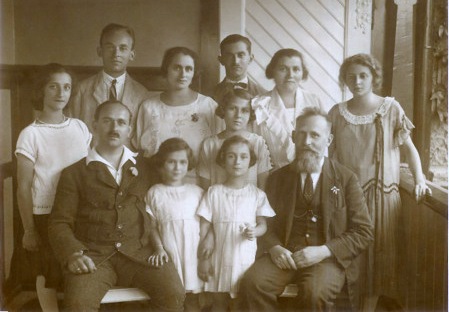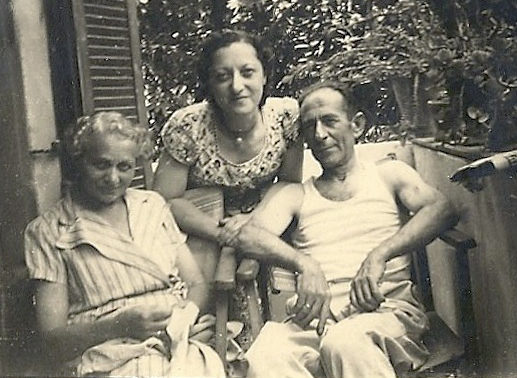
This is Day 19 of The Family History Writing Challenge. I’ll pick up where Day 18 left off, with Helene and Siegmund Kornmehl fleeing Vienna to Palestine.
The context: I was describing the mystery of the late-life adoption of Erika by the subject of this challenge, Adolf and Bertha Schweizer, and went off on the tangent of the Kornmehl family’s other late-life adoption, that of Stella Schmerling by Helene Kornmehl.
The Freud Museum Vienna’s “Politics of Reparations” document that I referred to yesterday says that Helene and Siegmund Kornmehl left Austria in May 1939.

Much of the above-cited document is in legalize but this part is pretty straightforward:
Helene Kornmehl – and, after her death, her adopted daughter Stella – had to pay the former occupant of their property in order to receive their houses back. In one case, the adoptive daughter refrained from pursuing the return of the property because the price was too high for her. Instead, she received a small payment in arrears from the current owners. Stella Löwinger [the married name of Stella Schmerling] received less than a fifth of the 245,000 Reichsmarks in “discriminatory payments” imposed on her adoptive parents. The rationale for this was that Stella’s adoption occurred too late: since she was not adopted by Helene Kornmehl until after the death of Siegmund Kornmehl, she could only claim the payments that her adoptive mother had personally made.
First the Jewish tax, now the woman tax. After all, most of the finances would have been in Siegmund’s name, although Helene signed enough documents to suggest she was an equal owner. And because the Nazi record keeping was so good — see Emigration Questionnaire Raises More Questions — the government would have found justification for slicing Helene’s inheritance down by four-fifths.
And this section of the “Politics of Reparation” helps to confirm why:
The legal reparation process in Austria was guided more by external pressures than by the motivation of Parliament itself. In 1946, the approach of the provisional government toward reports of confiscated property was to require the “Aryanizers” to report to the authorities that their current property had originally been taken from Jews. This system of reporting was intended to make the magnitude of the expected reparation demands more manageable.
In short, the Austrian government’s policy of giving property back to the Jews was imposed on them externally, and the owners of the seized property did everything they could to avoid complying. I can imagine there wouldn’t have been much enforcement in favor of the Jews.
From One of Stella’s Relatives
I’m not sure of the exact date of Siegmund and Helene’s departure from Vienna; I just know it couldn’t have been as early as May 1938.
I have a bit more information about David and Mitzi Schmerling, the great aunt and uncle whose daughter Stella was adopted by Helene Kornmehl (I realize when your grandparents have seven brothers and sisters this gets very confusing. Bear with me here). David and Mitzi had three children, two younger twins and Stella, who had polio as a child. The twins–my mother always called them Mimi and Ditti, but they were also called Herma for Hermine, and Edith for Edith–went to London in 1940, where they worked as jewelers. David, Mitzi, and Stella went to Palestine, where Stella married a man named Theo Loëwinger.

According to Stella’s niece/David and Mitzi’s granddaughter, “They went to Vienna with hope in their hearts and had nothing but aggravation and sadness.” She says:
Stella did inherit [Helene’s’] houses and that was the reason why my grandparents, Stella and her husband Theo returned from Palestine to Vienna. My grandfather had had a stroke and they thought that everything would be better back ‘home’. It wasn’t. The properties were all rented out and the tenants were on pre-war rent. The rent was not allowed to be increased and as a result of that no one wanted to move out; they only became vacant when someone died. There wasn’t enough money for upkeep and the properties deteriorated without the necessary maintenance. So one by one Stella sold them, very cheaply, in order to be able to maintain the others (there were originally three). They had no bathrooms and were very crumbly and old. She was advised to take out a huge mortgage to bring the house in Währingerstrasse where they were living, to a decent condition. This crippled the budget and she never paid it off in her lifetime.
David Schmerling died in 1956, three days after they took possession of the Währingerstrasse No. 97 apartment.

Neither of the pictures of Währingerstrasse — the one next to the title and the one directly above — show No. 97, where Stella and Mitzi Schmerling lived, but I saw the street in 1971 and, again, in 2014. But I’ll get to that tomorrow.

So sad! But I have a guess about the twins: that Herma (Mimi) is the twin on the right! I never met Edith, but I see something familiar in the Herma I knew, with the way she is holding her head. And the shape of the face. We’ll have to ask Rita!
Ah thanks! I did meet both of the twins in 1989 — that would be another post, for another blogging challenge — but not often enough and not long enough to have a clear idea.
Edith is the twin standing next to their father and the other one is Hermine (my mother)
Thank you! I made the change.